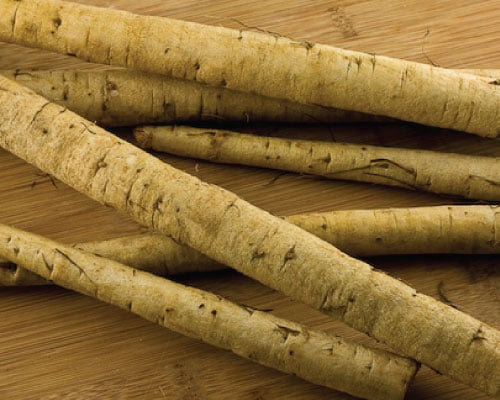
Learning Download: How to Grow Burdock
From Seed to Harvest: A beginner’s guide to growing Burdock.
Although burdock is native to Eurasia, it has quickly adapted to North America. It is a biennial with a history of herbal and medicinal uses. This is considered an easy plant to grow and has an interesting gamut of uses. The plant can reach up to 9 feet high and produces rough, sticky and burred fruits. It is known to be used for treatment of scalp or skin issues. Burdock root also can help with high blood pressure, and it can be applied directly to the skin to help with wrinkles, dry skin, acne and more.
To plant:
Plant in loamy soil with a neutral pH. Stratify the seeds prior to planting and plant them at 1/8 inch under the soil. Direct sow the seeds after the last frost, or they can be started early indoors up to four weeks before the last frost. Space the seeds 18 inches apart since this plant can grow fairly large and keep the soil evenly moist. Seeds should germinate in one to two weeks.
To grow:
The good news is burdock rarely struggles with pests or diseases. however, actions need to be taken to control the spread of the plant. Burdock can grow in a variety of conditions, from partial shade to full sun. Make sure to not plant other vegetables or plants near burdock, since it will quickly overtake an area.
To harvest:
Burdock leaves should be harvest while they are young and tender. In its second year of growth it will produce purple flowers. Burdock root and leaves can be harvested as early as 8 to 12 weeks after sowing the seeds in the spring. If burdock becomes too large, it will quickly become difficult to harvest, which is why it is important to harvest the plant while its young. To harvest the plant, use a shovel or garden fork. Dig a hole next tot he root so you can leverage the roots into that space. Burdock root can be eaten raw or cooked, and it is an excellent source of folate, vitamin C and pantothenic acid.
What burdock craves:
Since burdock is such an aggressive plant, it doesn’t need fertilizer to grow. However, if you notice your plants aren’t growing as quickly as they should or aren’t producing as well, add a balanced fertilizer.
Where to buy burdock seeds:
You can find burdock seeds that will produce a hardy root vegetable that is great for winter markets at Urban Farmer.
Learning Download: Common pests and diseases: Burdock
Common pests and diseases: Burdock
When growing vegetables, it is always exciting to care for the plant throughout its growing phase and then harvest it for delicious recipes later on, but one thing to watch out for is pests and diseases. Different plants are susceptible to different types of pests and diseases, and it is important to make yourself aware so you can keep a watchful eye and also take any preventative methods to keep your plants safe throughout their lifespan.
Burdock is generally resistant to a number of pests and diseases, but there are certain issues that can arise.
Pests:
Burdock is resistant to most pests as well as diseases, but slugs can actually be a problem for this plant. Snails and slugs are oftentimes hard to get rid of and they are unsightly, but there are certain methods you can take to rid your garden of these pests. One way to prevent slugs is to clean up the garden itself so the slugs can’t seek shelter in unnecessary plants and debris. Another way to prevent these pests is to remove fallen fruit or vegetables from the garden because slugs enjoy feeding on these items. If you have a poorly managed compost area, this also provides shelter, food and an environment to lay eggs in, so make sure you tidy up your compost area.
Since slugs are nocturnal, it is suggested you water in the morning and not in the evening, because slugs like moisture and if you water in the evening, it creates optimal conditions for the slugs to thrive in your garden.

If you do find slugs in your garden, kill them early, such as in the spring, because this will prevent egg laying. To kill the slugs, use a shovel to cut off their heads, which is the easiest way to kill them. Boiling water also will kill them. Or, you can use tweezers to pick them up and put them in a container with concentrated washer fluid, which also will kill them instantly. Another method is by using a beer trap, where you dig a hole in the ground and hide an open container or bowl of beer there. Empty the container daily.
Diseases:
Burdock is resistant to most diseases, so as a gardener, you probably won’t struggle too much with diseases with this plant. However, the burdock itself can become a problem, because it is known to be an invasive plant. The plant will oftentimes spread spontaneously, so to prevent this, you should work to not allow the plant to flourish. Cut off the flowers before they fade, because this will prevent seeding from occurring and then seed spilling to occur. Another popular way to counter invasiveness is to keep burdock contained to a confined space while growing.

